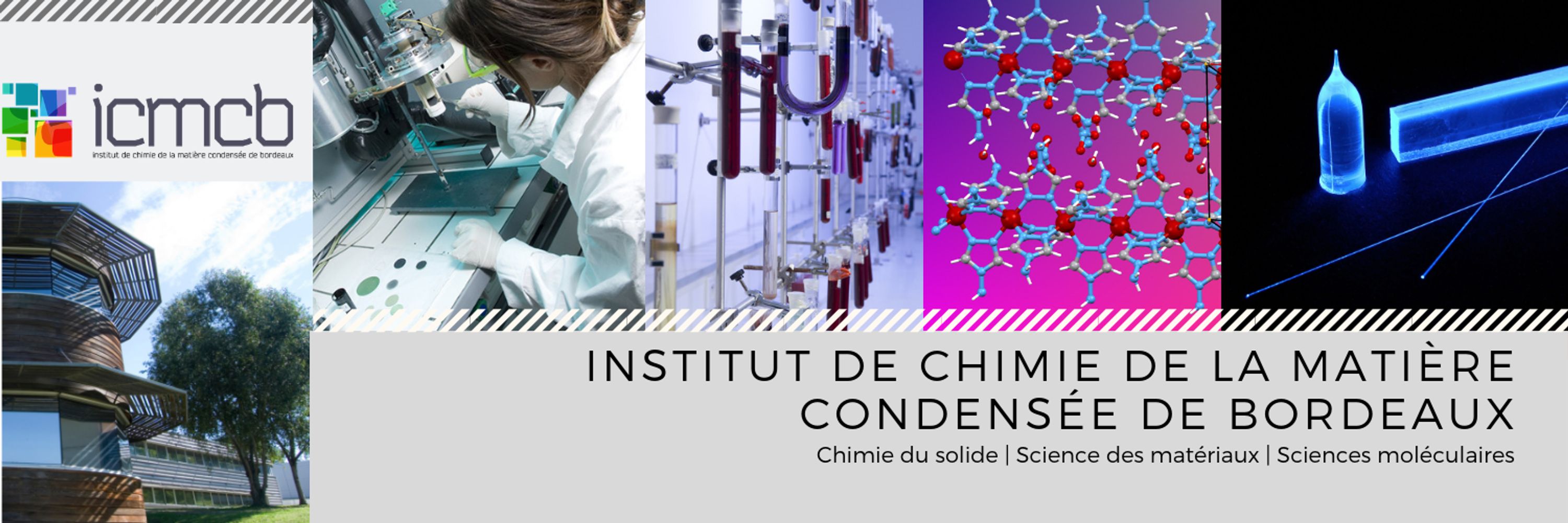
Concevoir, caractériser, modéliser, assembler et recycler les #matériaux du futur
#Chimie #energie #recherche #environnement
@cnrsaquitaine.bsky.social @univbordeaux.bsky.social @BordeauxINP


Are you ready ?
icmm2025.sciencesconf.org
@cnrsaquitaine.bsky.social @cnrs.fr @univbordeaux.bsky.social #Bordeaux_INP


Are you ready ?
icmm2025.sciencesconf.org
@cnrsaquitaine.bsky.social @cnrs.fr @univbordeaux.bsky.social #Bordeaux_INP
#ArtEtScience Antony Maubert (Association NEXSO) et Sylvain Danto (ICMCB), aura lieu le samedi 4 octobre à 15h à la médiathèque Castagnéra de Talence
⏩ lnkd.in/eCkEVDV9
@univbordeaux.bsky.social @cnrsaquitaine.bsky.social
#Bordeaux_INP #Talence

#ArtEtScience Antony Maubert (Association NEXSO) et Sylvain Danto (ICMCB), aura lieu le samedi 4 octobre à 15h à la médiathèque Castagnéra de Talence
⏩ lnkd.in/eCkEVDV9
@univbordeaux.bsky.social @cnrsaquitaine.bsky.social
#Bordeaux_INP #Talence
@cnrs.fr @cnrsaquitaine.bsky.social @univbordeaux.bsky.social #BordeauxINP
youtu.be/_eW6hM5gKXk?...

@cnrs.fr @cnrsaquitaine.bsky.social @univbordeaux.bsky.social #BordeauxINP
youtu.be/_eW6hM5gKXk?...
@icmcb.bsky.social @sudouest.fr @cnrsaquitaine.bsky.social
#BordeauxINP
www.sudouest.fr/gironde/pess...

@icmcb.bsky.social @sudouest.fr @cnrsaquitaine.bsky.social
#BordeauxINP
www.sudouest.fr/gironde/pess...
Retrouvez le communiqué de presse ici ➡ www.aquitaine.cnrs.fr/fr/cnrsinfo/...

Retrouvez le communiqué de presse ici ➡ www.aquitaine.cnrs.fr/fr/cnrsinfo/...
↘️ lnkd.in/dUKVA-Qq

↘️ lnkd.in/dUKVA-Qq
@cnrsaquitaine.bsky.social @univbordeaux.bsky.social #BordeauxINP #30ansICMCB
➡️ lnkd.in/eqr6hxxV


@cnrsaquitaine.bsky.social @univbordeaux.bsky.social #BordeauxINP #30ansICMCB
➡️ lnkd.in/eqr6hxxV
@cnrsaquitaine.bsky.social @univbordeaux.bsky.social #bordeaux_inp #PECLABEL
➡️ lnkd.in/ekSmQr_2

@cnrsaquitaine.bsky.social @univbordeaux.bsky.social #bordeaux_inp #PECLABEL
➡️ lnkd.in/ekSmQr_2
#ChemSky
pubs.acs.org/doi/10.1021/...

#ChemSky
pubs.acs.org/doi/10.1021/...
Have a look here : emploi.cnrs.fr/Offres/Docto...
@icmcb.bsky.social
Have a look here : emploi.cnrs.fr/Offres/Docto...
@icmcb.bsky.social
Nouvelle technologie @icmcb.bsky.social #stockage électrochimique à base de géopolymères #matériaux de construction #CNRS_Chimie
⏩ lnkd.in/eiYWqMkA
@cnrsaquitaine.bsky.social @univbordeaux.bsky.social @cnrs.fr #Bordeaux_INP

Nouvelle technologie @icmcb.bsky.social #stockage électrochimique à base de géopolymères #matériaux de construction #CNRS_Chimie
⏩ lnkd.in/eiYWqMkA
@cnrsaquitaine.bsky.social @univbordeaux.bsky.social @cnrs.fr #Bordeaux_INP
@aberdeenchem.bsky.social @utaustin.bsky.social @icmcb.bsky.social

@aberdeenchem.bsky.social @utaustin.bsky.social @icmcb.bsky.social
@cnrsaquitaine.bsky.social
www.inc.cnrs.fr/fr/cnrsinfo/...

@cnrsaquitaine.bsky.social
www.inc.cnrs.fr/fr/cnrsinfo/...

@cnrsaquitaine.bsky.social @univbordeaux.bsky.social BordeauxINP

@cnrsaquitaine.bsky.social @univbordeaux.bsky.social BordeauxINP
@cnrsaquitaine.bsky.social @univbordeaux.bsky.social
www.inc.cnrs.fr/fr/cnrsinfo/...

@cnrsaquitaine.bsky.social @univbordeaux.bsky.social
www.inc.cnrs.fr/fr/cnrsinfo/...
@cnrsaquitaine.bsky.social @univbordeaux.bsky.social
➡️ urlr.me/v8U2mV

@cnrsaquitaine.bsky.social @univbordeaux.bsky.social
➡️ urlr.me/v8U2mV
Abstract submission and registration are now open !
• April 11, 2025: Abstract submission deadline
• End of May 2025: Oral or poster presentation notification to authors
• June 6, 2025: Early registration deadline
icmm2025.sciencesconf.org?lang=en

Abstract submission and registration are now open !
• April 11, 2025: Abstract submission deadline
• End of May 2025: Oral or poster presentation notification to authors
• June 6, 2025: Early registration deadline
icmm2025.sciencesconf.org?lang=en
@cnrs.bsky.social @cnrsaquitaine.bsky.social
@univbordeaux.bsky.social @BordeauxINP

@cnrs.bsky.social @cnrsaquitaine.bsky.social
@univbordeaux.bsky.social @BordeauxINP

